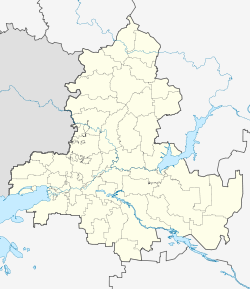Shakhty
| city
Shakhty
ахты
|
||||||||||||||||||||||||||||||||||||||||||||
|
||||||||||||||||||||||||||||||||||||||||||||
|
||||||||||||||||||||||||||||||||||||||||||||
| List of cities in Russia | ||||||||||||||||||||||||||||||||||||||||||||
Shakhty ( Russian Ша́хты ) is a city in southern Russia in the Rostov Oblast . It has 239,987 inhabitants (as of October 14, 2010).
geography
The city is the for the southeastern foothills of the East European Plain belonging Donezrückens , to about 100 meters. After the regional capital Rostov-on-Don and the city of Taganrog , Shakhty is the third largest place in Rostov Oblast in terms of population.
The distance to Rostov is around 75 km in a south-westerly direction. The two closest cities are Krasny Sulin (23 km northwest of Shakhty) and Novoshakhtinsk (25 km west).
history
The development of the city is closely linked to the mining of hard coal in this region. At the beginning of the 19th century, the first coal mine was built near what is now the city, and by 1850 there were already 57 developed deposits here, including one called Gruschewski , around which a mining settlement later began to form. The official founding year of Shakhty is 1867, when the town of Gornoje Gruschewskoje (Russian Горное Грушевское ), later the city of Shakhty, was officially recognized at the Grushevsky deposit . On January 3, 1883, the settlement received city rights and at the same time was renamed Alexandrowsk-Grushevsky (Russian Александровск-Грушевский ) in memory of Tsar Alexander II, who had been murdered almost two years earlier . Towards the end of the 19th and beginning of the 20th century, the site was one of the most important coal mining centers in southern Russia.
On February 11, 1920 Alexandrowsk-Grushevsky was officially renamed Shakhty (translated " mines ", in the plural). Until October 1925, Shakhty was administratively part of the Ukrainian SSR , after which it was incorporated into the Rostov Oblast of the RSFSR . Like the neighboring city of Novoschachtinsk , Shakhty was also characterized by coal mining during the Soviet Union.
In 1928, the Shakhty Trial was the first Stalinist show trial against non-communist specialists , and during the Second World War the city came under German occupation for several months in July 1942, which caused considerable destruction and civilian casualties. In the post-war period, however, Shakhty could be rebuilt, with a number of new industrial establishments.
In the city there was the POW camp 182 for German prisoners of war of the Second World War . It was dissolved in 1954.
In 2004 the urban-type settlements Ajutinski (2002: 10,639 inhabitants) and Maiski (12,155) were incorporated.
Population development
| year | Residents |
|---|---|
| 1897 | 16,479 |
| 1939 | 114.134 |
| 1959 | 196.190 |
| 1970 | 205,307 |
| 1979 | 209,495 |
| 1989 | 225,797 |
| 2002 | 222,592 |
| 2010 | 239.987 |
Note: census data
economy
While coal mining was the dominant industry in Shakhty and other cities in the Donets Basin during the Soviet era, most of the mines were shut down during the Russian economic crisis of the 1990s, impoverishing the city. Today there are around 3,500 companies in Shakhty, including metallurgy, building materials and ceramics production (e.g. Unitile ) as well as the light and food industries.
traffic
Shakhty is on the Russian trunk road M 4 , from which the M 19 branches off, which leads to Donetsk in the Ukraine. There is a train station in the city with connections to Rostov, among others. Urban public transport consists exclusively of buses and regular taxis; the networks of tram and trolleybus lines that once existed have now been dissolved.
Town twinning
Schachty has had a town partnership with the North Rhine-Westphalian city of Gelsenkirchen since 1989 .
Further educational institutions
- Shakhty University Institute of the South Russian State Technical University
- South Russian State University of Economy and Service
people
sons and daughters of the town
- Vladimir Lotaryov (1914–1994), designer of jet engines
- Lyudmila Kondratjewa (* 1958), athlete
- Marina Logwinenko (* 1961), marksman
- Viktor Tregubov (* 1965), weightlifter
- Sergei Kowalenko (* 1976), wrestler
- Andrei Silnow (* 1984), track and field athlete
- Nikita Melnikow (* 1987), wrestler
Other well-known personalities
- Timofei Prokhorov (1894-2004), hermit; worked in Shakhty during the Second World War .
- Andrei Tschikatilo (1936–1994), serial killer; lived with his family in Shakhty from the mid-1970s and worked as a teacher and clerk; in Shakhty he committed his first murder.
- Wassili Alexejew (1942–2011), weightlifter; Honorary citizen of Shakhty.
- Gennadi Bessonow (* 1954), weightlifter; Honorary citizen of Shakhty.
Individual evidence
- ↑ a b Itogi Vserossijskoj perepisi naselenija 2010 goda. Tom 1. Čislennostʹ i razmeščenie naselenija (Results of the All-Russian Census 2010. Volume 1. Number and distribution of the population). Tables 5 , pp. 12-209; 11 , pp. 312–979 (download from the website of the Federal Service for State Statistics of the Russian Federation)
- ↑ Постановление Президиума ЦИК CCCP от 16 October 1925 «Об урегулировании границ Украинской Социалистической Советской Республики с Российской Социалистической Федеративной Советской Республикой и Белорусской Социалистической Советской Республикой "
- ↑ Maschke, Erich (Ed.): On the history of the German prisoners of war of the Second World War. Verlag Ernst and Werner Gieseking, Bielefeld 1962–1977.
- ↑ Бессонов Геннадий Вениаминович , культура-шахты.рф (Russian)
Web links
- Official city website (Russian)
- Shakhty on mojgorod.ru (Russian)
- Unofficial Portal (Russian)




